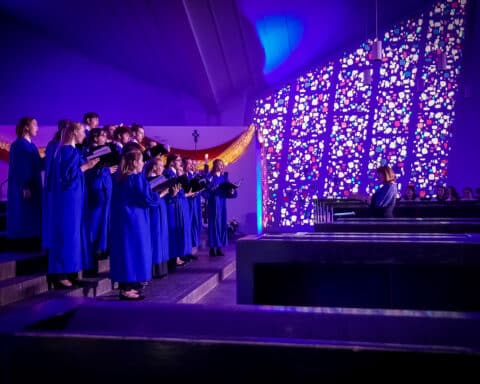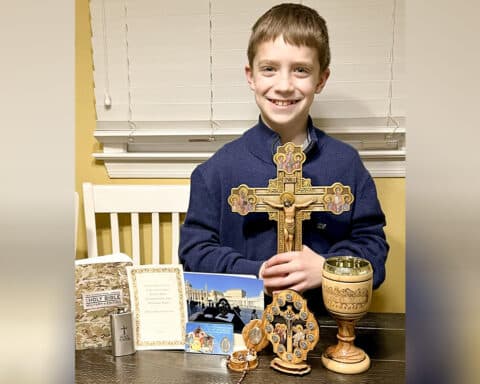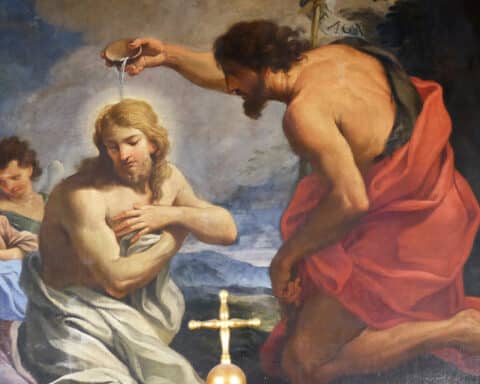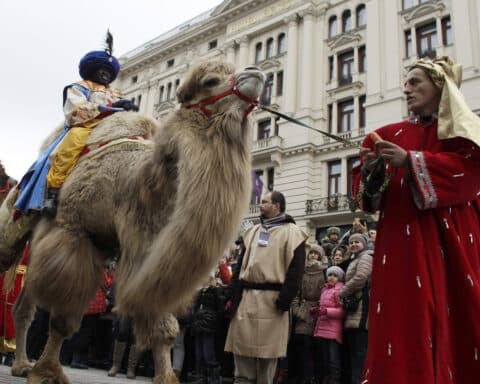In 1739, Charles Wesley published the text of “Hymn for Christmas-Day” in “Hymns and Sacred Poems.” This hymn was one of over 6,500 hymns Wesley would compose during his lifetime as a leader of the Methodist movement in England. “Hymn for Christmas-Day” begins with a couplet that might seem vaguely familiar to the modern reader: “Hark! how all the welkin rings / Glory to the King of kings.”
“Welkin” is certainly an unfamiliar term in today’s vocabulary — its usage may have already been in decline at Wesley’s time — but it gives the modern reader insight into the profound splendor Wesley conveys in his hymn. Welkin, derived from the Middle English term welken, refers to the expanse of heaven, God’s dwelling. From the very first line of text, Wesley establishes the expansive scope of one of the most theologically-rich carols of the Christmas season: “Hark! The Herald Angels Sing.” So, how did this beloved carol come to be?
Evolution of the text
The original “Hymn for Christmas-Day” in “Hymns and Sacred Poems” consists of 10 stanzas, each with four lines. The modern version of the hymn, however, has evolved from this form. In 1753, George Whitefield, an influential figure in the Calvinist movement in Methodism, initiated a series of evolutions for the piece when he published it in his “Hymns for Social Worship.” Perhaps most notably, he changed the opening couplet of the text to reflect what is currently sung: “Hark! The herald angels sing / Glory to the newborn King.” He also excluded two verses of text.
We do not have a sense of Wesley’s thoughts on this modified text — there is no known record of an opinion on the matter. However, his brother, John Wesley, criticized hymn modification in his preface to “A Collection of Hymns for the Use of the People called Methodists” over 20 years later. In it, he asks those who republish Wesley works to either refrain from modification, or otherwise print original texts by modifications, so that the Wesley brothers would “no longer be accountable either for the nonsense or for the doggerel of other men.” Yet, it is Whitefield’s modified text that has survived into popular use; indeed, John Wesley even used it in his hymn collection!
A sacred tune for sacred words
Even the carol’s melody may have surprised Charles Wesley. A prolific composer of hymn tunes himself, Wesley planned for the carol to be sung to his “Easter Hymn” — the same melody he composed for “Christ the Lord Is Risen Today,” and what we may also associate with “Jesus Christ Is Risen Today.” He wanted to connect the Christmas texts and Easter texts through this tune, a musical link which would benefit the Christian’s understanding of Christ’s incarnation — God becoming flesh — and resurrection.
Even when it was not sung to “Easter Hymn,” “Hark! The Herald Angels Sing” maintained its four-line stanza structure throughout the 18th century. It was only in 1769, 30 years after Wesley published his original text, that the first eight-line verses appeared in Martin Madan’s “Lock Collection.” This version is reproduced in the “New Oxford Book of Carols,” but is rarely used today. English country choirs largely continued singing the hymn in quatrains well into the 19th century, but this eight-line structure would be the foundation for later versions of the carol. William Mercer, for example, set the text to a tune called “Coburg” in “The Church Psalter and Hymn Book” using this model.
The tune we have come to associate with “Hark! The Herald Angels Sing” was originally written for a very different purpose. In 1840, Felix Mendelssohn composed “Festgesang,” also known as the “Gutenberg Cantata,” for the 400th anniversary of Johannes Gutenberg’s movable-type printing press in Leipzig, Germany. Mendelssohn saw that one chorus from the second movement of “Festgesang” could be fit for a new text. In a letter to his English publisher in 1843, Mendelssohn wrote: “If the right [words] are hit at, I am sure that piece will be liked very much by the singers and the hearers.” However, he felt it unsuitable for any type of sacred music, adding that “it will never do to sacred words.”
In the early 1850s, an organist from Essex named W. H. Cummings was looking through the score for “Festgesang.” Cummings was no stranger to Mendelssohn’s work, as he had sung under Mendelssohn’s direction at the first London performance of “Elijah.” When he reached the second movement of the “Festgesang,” he remarked that a certain chorus would be quite appropriate for “Hark! The Herald Angels Sing” — the very same chorus Mendelssohn had noted a decade earlier.
Without knowing of Mendelssohn’s constrictions on its use as a sacred hymn, Cummings adapted this chorus for the text, a setting first published in 1856 by Richard Chope in his “Congregational Hymn and Tune Book.” Chope named the tune “St. Vincent,” and it was subsequently published in the “Wesleyan Sunday School Tune Book” (1858) as “Berlin.” In 1861, W. H. Monk published it as “Mendelssohn” in the first edition of “Hymns Ancient and Modern.” This hymnal, responsible for “so many marriages between words and tunes” (“The Penguin Book of Carols,” 1989), would cement the text and tune as we know it today.
In the world
Since this union of text and tune, “Hark! The Herald Angels Sing” has become one of the world’s most popular Christmas carols, holding a place in both liturgical settings and pop culture. Perhaps one of the most famous versions of the carol was adapted by Sir David Wilcocks (1919-2015) during his time as choral director of King’s College. Wanting to reanimate the carol for the King’s College service of Nine Lessons and Carols, Wilcocks added a descant to the third verse. This arrangement has been sung in the service ever since.
“Hark! The Herald Angels Sing” is also the ending theme of “A Charlie Brown Christmas.” When Linus recites Luke 2:8-14 (the angel’s annunciation of Christ’s birth to the shepherds), a hopeful Charlie realizes that commercialism cannot take away the true meaning of Christmas. He attempts to decorate the sapling he picked out with a single red ornament, but the weight of the ornament causes the tree to bend over, and he leaves in defeat. His friends then decorate the tree for him, humming the tune of “Hark! The Herald Angels Sing.” Charlie, upon hearing his friends, returns to find a beautiful Christmas tree, and joins in singing the carol with his friends.
What we can take away
The first three verses of “Hark! The Herald Angels Sing” are rather familiar to the modern audience. And though, as a hymnology enthusiast myself, I encourage meditation on hymn texts in their entirety, for now, let us focus on the last four quatrains of Wesley’s text, which have been largely lost in carol singing and publishing. These verses offer some rich theological ideas to us to meditate on as we enter the Christmas season:
Come, Desire of nations, come,
Fix in us Thy humble home;
Rise, the woman’s conqu’ring Seed,
Bruise in us the serpent’s head.
Now display Thy saving power,
Ruined nature now restore;
Now in mystic union join
Thine to ours, and ours to Thine.
Adam’s likeness, Lord, efface,
Stamp Thine image in its place:
Second Adam from above,
Reinstate us in Thy love.
Let us Thee, though lost, regain,
Thee, the Life, the inner man:
O, to all Thyself impart,
Formed in each believing heart.
“Hark! The Herald Angels Sing” invites us to enter more deeply into the mystery of Christ’s incarnation. How often are we reminded of the protoevangelium — the first proclamation of the Gospel in Genesis 3:15 — in a Christmas carol? Christ’s becoming flesh fulfills the Lord’s promise in Genesis, restoring his people.
As believers, we are called to faith, hope and love. Faith in the Incarnate Lord, who dwells among us. Hope in the salvation he brings. And love, that Divine Love who put aside his glory, coming as a baby in a manger, to redeem the world.
This Christmas, let us remember God’s faithfulness, joining in that angelic song of praise: “Glory to the newborn King!”
Victoria Costa is a graduate student at the University of St. Andrews in Scotland.





